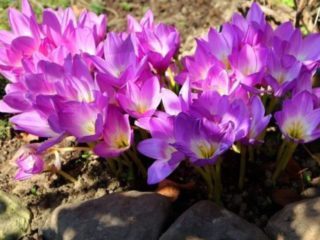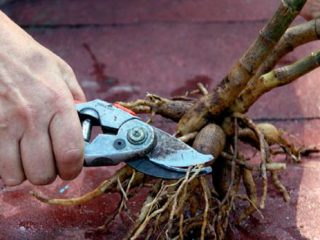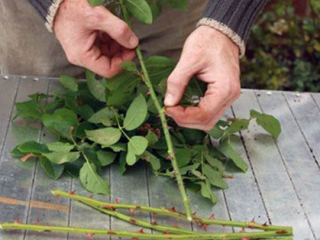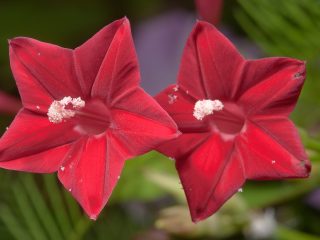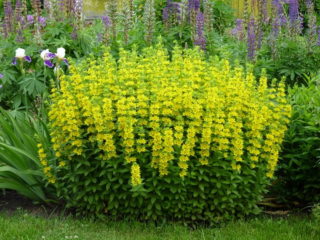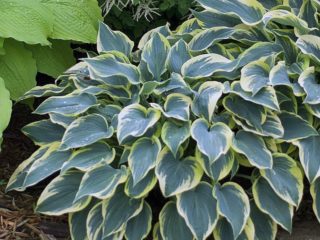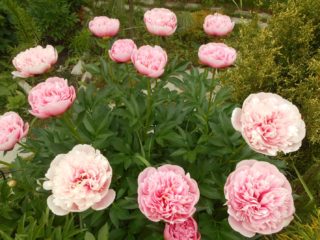Content
- 1 What does Colchicum look like?
- 2 Difference between colchicum and crocus
- 3 When does colchicum bloom in autumn?
- 4 How does Colchicum reproduce?
- 5 Types and varieties
- 6 Planting and caring for crocus flowers in open ground
- 7 Diseases and pests
- 8 Medicinal properties of colchicum and contraindications
- 9 What plants does it go with?
- 10 Conclusion
The colchicum flower is a beautiful and fairly unpretentious plant that can decorate the garden in late autumn just before the onset of winter. Breeding it is not difficult if you know the basic rules.
What does Colchicum look like?
Colchicum is a perennial plant from the Colchicum family.It has short stems, 3-4 large elongated green leaves rise from the underground bulb in the spring. The plant’s plates are erect, and due to them it can rise 40 cm above the ground. Other names for colchicum are autumn flower (Colchicum) or colchicum.
Some plant species produce leaves and buds simultaneously in early spring, immediately after the snow melts. Others at the beginning of the growing season bring only greenery, which fades with the onset of summer, and the flowering of colchicum occurs in August.
In both cases, 3-4 stems up to 30 cm in height grow from the bulbous part of the autumn forest. Each of them is decorated with a funnel-shaped bud with double or simple petals. The flowers are most often purple or brownish, but yellow, pink or white colchicums are also found. The decorative period of the plant lasts up to three weeks.
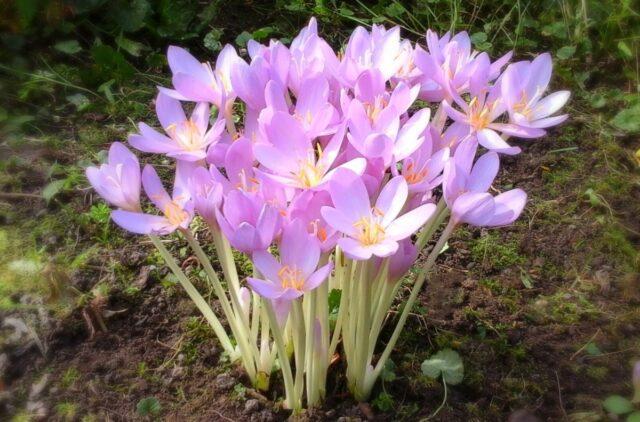
During flowering, the perennial autumn plant emits a subtle pleasant aroma
Autumn flowers are widespread throughout the world. You can meet it in the Mediterranean and Asian countries, in Africa. In Russia, it grows naturally in the southern regions - in the Krasnodar Territory and the Caucasus.
Difference between colchicum and crocus
From the photo and description of the colchicum flower, it is noticeable that in appearance it is very similar to a crocus. But plants have differences in structure and characteristics:
- The bud of renewed growth in crocuses is located at the top of the corm, and in autumn plants - at the base.
- A crocus flower has three stamens and one pistil. Colchicum has six stamens and three pistils.
- The autumn plant can bloom within a couple of weeks after planting, while the crocus enters the decorative phase only after a month and, moreover, rarely blooms in the autumn.
An important difference is that colchicum is a poisonous flower containing the dangerous alkaloid colchicine. The harmless crocus, meanwhile, serves as a raw material for the production of the spice saffron.
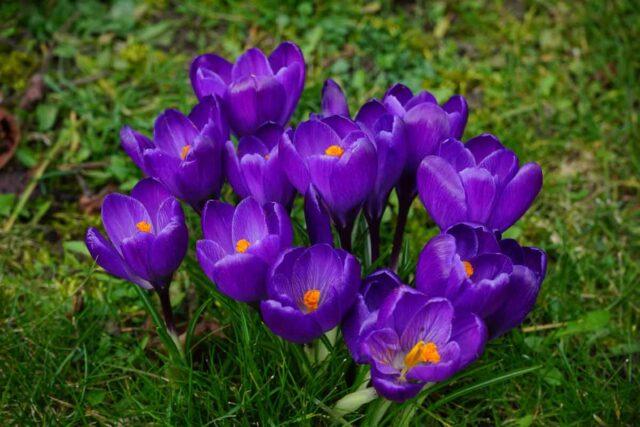
In color, many types of crocus are much brighter than autumn flowers
When does colchicum bloom in autumn?
Some colchicums bloom in the spring, while other species typically bloom in autumn. It begins at the end of September and lasts about a month until the last days of October.
How does Colchicum reproduce?
The garden flower Colchicum can be propagated in two ways - by bulbs and seeds. The first method is mainly used because it is simpler and accessible even to beginners.
Propagation by bulbs
Adult healthy colchicums produce miniature daughter bulbs that grow from the main tuber in the underground part. You can recognize their presence by the appearance of a large number of stems and leaves above the ground during the autumn growing season.
The “babies” are selected in the summer, after the colchicum has completely faded. The tubers of the plant are dug up at the end of July, being careful not to damage the roots, and the small bulbs are carefully separated from the main part. The autumn planting material is kept in a cool place for a month or two to strengthen its hardiness, and then planted in the ground.
Propagation by seeds
Seed propagation of crocus is a rather long and labor-intensive task. Planting material is collected from mature plants in June. The bolls of the autumn plant are cut off even before they darken and open, dried in the shade, and when they become brittle, the seeds are removed.
To increase the endurance of future plants, planting material must be kept in a cool place in a moistened substrate for at least a month. After this, autumn seeds can be sown in boxes and germinated at home or buried directly in the ground in August. It should be borne in mind that colchicum grows very slowly. The first greenery may appear only in the fall of the next season. It will take about five years for the seeds to fully develop. Only after such a period will the crocus be able to produce mature flower stalks with beautiful buds.
Types and varieties
The decorative autumn garden is represented by a wide variety of species. We can highlight several of the most popular varieties of colchicum with photos and names.
Yellow (Colchicum luteum)
Yellow colchicum occurs naturally in the rocky glacial regions of Tibet, the Himalayas and the Tien Shan. The height does not exceed 15 cm. The plant’s flat, dark green leaves appear simultaneously with miniature bright yellow flowers immediately after the snow melts.
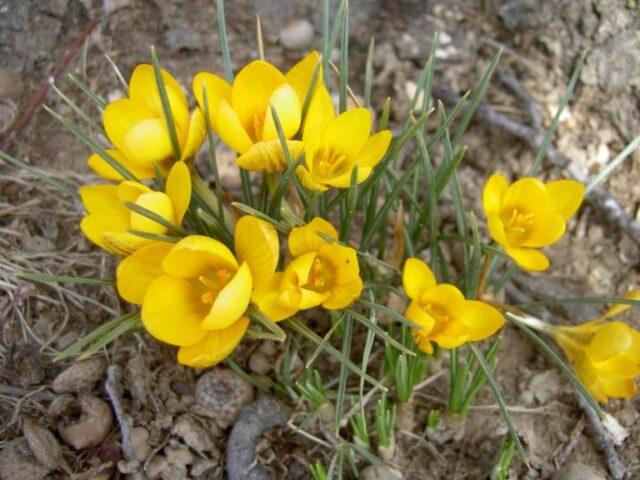
Yellow colchicum has been cultivated artificially since 1882
Hungarian (Colchicum hungaricum)
The species is found in Greece, Albania and Hungary, and enters the decorative period at a time that is unusual for colchicum - in early spring or late winter. Produces white or purple-pink buds with dark burgundy anthers, the leaf blades in the upper part are densely covered with hairs.
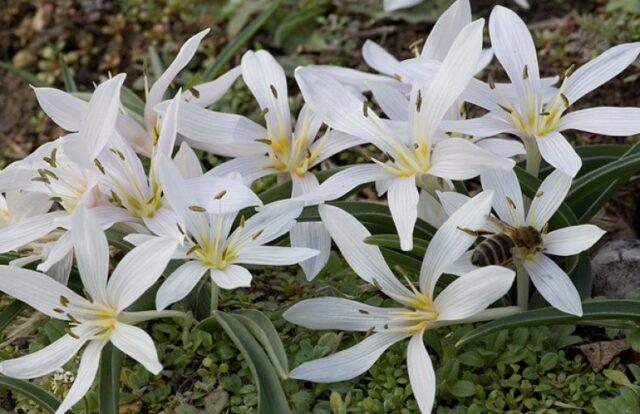
Hungarian colchicum blooms simultaneously with the appearance of leaves
Ankara (Colchicum ancyrense)
Ankara colchicum is one of the earliest and can bloom from the end of December until April. Under natural conditions it grows in Crimea and southwestern Ukraine, Moldova and Turkey. Brings pink-purple buds, the narrow grooved leaves of the colchicum have a bluish tint.
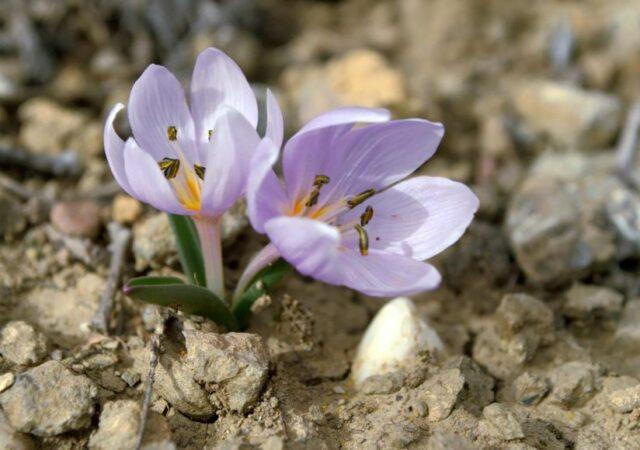
The Ankara colchicum blooms for about two weeks.
Regel (Colchicum regelii)
Colchicum Regel is distributed in alpine and subalpine regions at an altitude of 2000 m above sea level. Bears several grooved, blunt-pointed leaf blades with a smooth or finely toothed edge, produces white buds. On the underside of the lobes of the flowers you can see purple stripes.

Colchicum Regel's flowering begins immediately after the snow melts
Autumn (Colchicum autumnale)
One of the most popular species rises up to 40 cm above the ground, is common in Europe and is actively cultivated in Russia. In spring, colchicum produces erect, oblong leaves that fade by early summer. Autumn bears buds from mid-September; they are light or pale lilac in color, often with a lush structure. White double crocus is of the greatest decorative value.
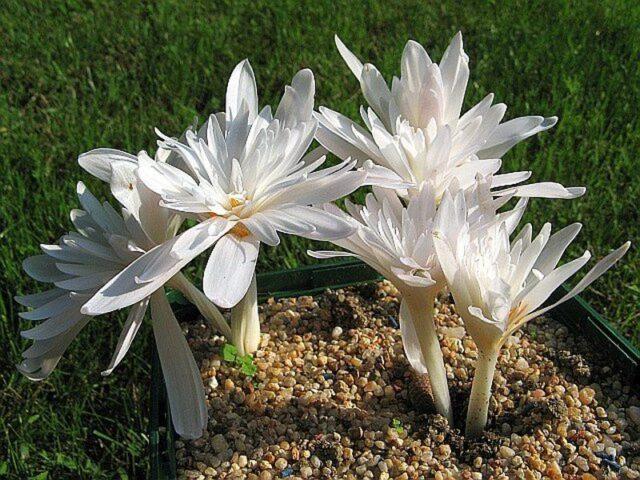
Autumn colchicum flowers reach 7 cm in diameter
Magnificent (Colchicum speciosum)
The magnificent pink colchicum can be seen growing wild in Iran, Transcaucasia and Turkey. It can grow up to 50 cm in height and has long leaves with a wavy edge. It blooms in September, the buds of the plant are lilac or pale pink. The length of autumn leaf blades reaches 30 cm.
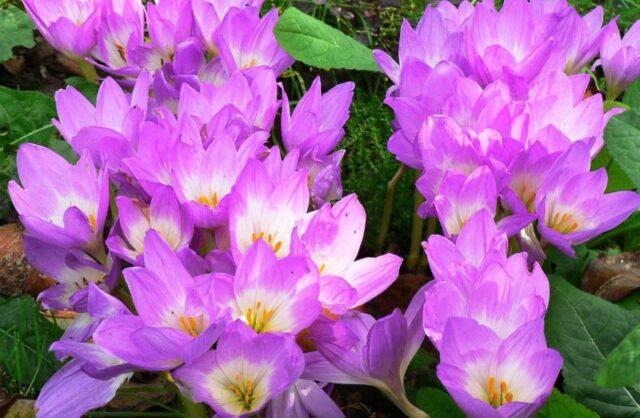
In the middle of the flower, the magnificent autumn flower has a white bell
Bornmueller (Colchicum bornmuelleri)
Colchicum Bornmüller grows in the mountains of Asia Minor. It has long leaves up to 35 cm, the buds of the species are pale lilac in color. The autumn plant is able to maintain its decorative appearance from September until frost.

Colchicum Bornmüller prefers well-lit areas
Byzantine (Colchicum buzatinum)
Byzantine colchicum is widespread in the Mediterranean and Southern Europe. In spring it produces long lanceolate leaves up to 30 cm, and at the end of August it bears purple buds. Autumn flowers remain attractive until cold weather.
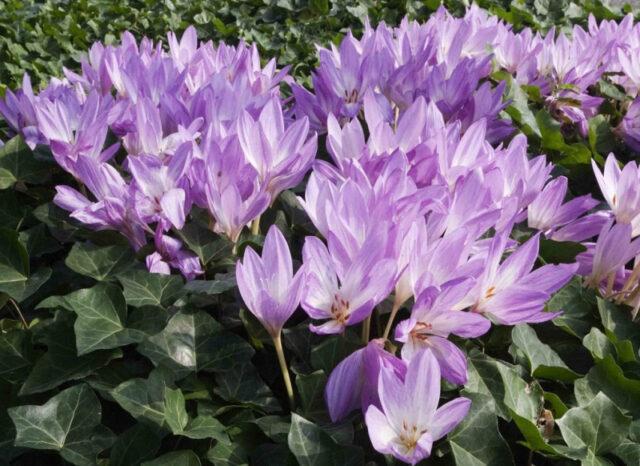
One Byzantine autumn flower can produce more than 12 buds
Planting and caring for crocus flowers in open ground
Autumn trees are quite easy to grow, but require compliance with some rules. First of all, you need to know the preferences of the plant and the optimal planting time.
When to plant colchicum bulbs
For species with autumn flowering, it is practiced to plant colchicum in August no later than the middle of the month. If the corm of a perennial is large and healthy, then buds can be expected already in the current season.
Requirements for place and soil
The autumn plant feels best in well-lit or slightly shaded areas. The plant needs moisture, but in waterlogged soil its roots may rot. Therefore, the soil needs to be well-drained and without groundwater lying close to the surface. Colchicum develops on alkaline and acidic soils; it loves loams.
How to plant colchicum
Immediately before planting the bulbs, it is necessary to dig up the area and, if necessary, improve the soil, add 0.5 buckets of sand and a bucket of humus per square meter. You should also prepare holes, about 8 cm deep for small tubers and 20 cm for large ones. Wood ash and superphosphate are first added to the holes and mixed with soil.
Autumn planting material is lowered into the holes, leaving scaly tubes above the surface of the earth, from which flower stalks will subsequently appear. The soil around the colchicum is slightly compacted and the plant is immediately watered using irrigation.
Aftercare
Caring for the plant comes down mainly to timely watering and fertilizing. Colchicum should be moistened during the flowering period, subject to dry weather. The rest of the autumn season there will be enough natural precipitation.
Colchicum is fertilized three times per season, when the leaves are growing, before flowering and during the period of maximum decorativeness. Complex minerals are used in a volume of 30 g per square meter of soil.
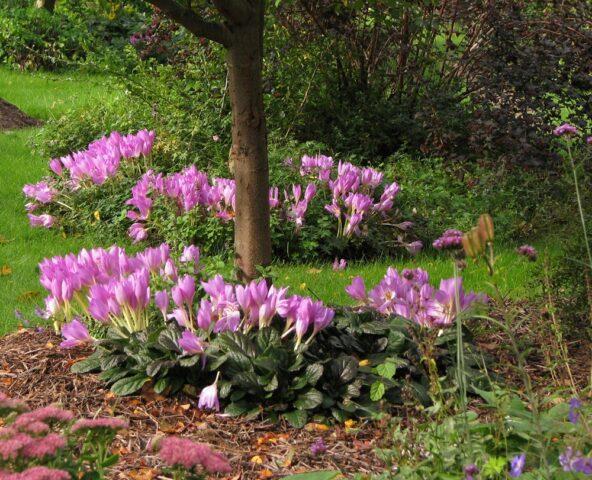
It is recommended to apply mineral fertilizers for autumn trees along with watering
To prevent weeds from appearing near the plant, the soil needs to be loosened from time to time. They do this carefully, trying not to damage the bulbs located near the surface of the earth. You can also mulch the crocus; a layer of peat or fallen leaves will slow down the evaporation of moisture and prevent the growth of weeds.
When to dig up colchicum
It is not customary to dig up autumn trees for the winter. It tolerates cold periods in the ground well. As for transplanting to a new location and dividing an adult plant, these procedures are carried out at the end of summer in August. But in both cases it is recommended to dig up the bulbs in advance, at the end of June, when the leaves of the colchicum turn yellow.
When to plant colchicum
If the autumn forest has grown greatly, it can be planted in several new places on the site. Plant bulbs are dug out of the ground at the standard time, at the end of June or beginning of July. The tubers are washed, dead roots are cut off, and the scales are left in place.
The planting material is soaked for half an hour in a pink solution of potassium permanganate for disinfection, after which it is removed to dry in a warm place with low humidity. Then the autumn bulbs must be placed in a cool cellar before being transferred to a new site.
When to replant colchicums that bloom in autumn
When caring for a crocus flower, it is recommended to replant it once every three years so that it does not grow too much, otherwise the buds will begin to shrink. Autumn bulbs are dug up in mid-summer or a little earlier, at the moment the leaves turn yellow, after which they are washed, disinfected and stored until August in a dark place.
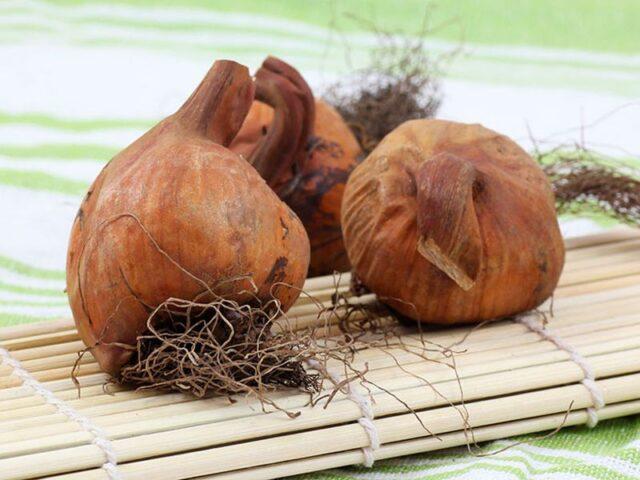
Thoroughly dried bulbs are kept at a temperature of about 24 ° C until planting.
Shortly before the onset of autumn, the perennial is transplanted to a new location. If the bulbs are healthy and strong, the buds will appear within a few weeks.
Diseases and pests
With proper cultivation and care, colchicum relatively rarely suffers from diseases. The greatest danger for it is gray rot.With this fungal disease, a light, fluffy coating resembling mold appears on the leaves of the plant and on the stems.
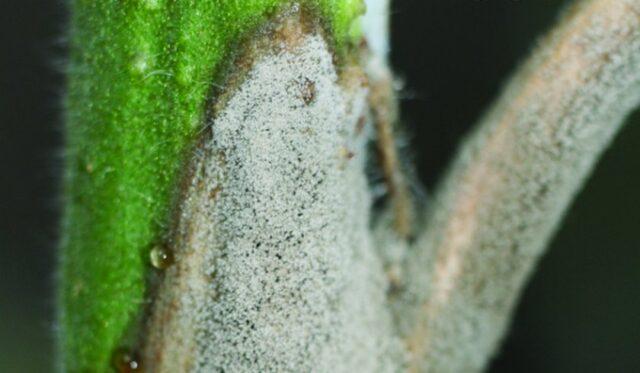
Gray rot develops due to waterlogging of the soil
In the first stages, autumn gray rot can be combated. Colchicum is treated with Topaz, Champion or Kuproksat fungicides, and the watering schedule is also revised. All affected parts must be removed and burned. If the autumn plant is too severely affected, and the underground bulb has suffered from rot, all that remains is to destroy the specimen so as not to infect neighboring plants.
Of the pests for crocus, the most dangerous are snails and slugs. Gastropods often appear on the broad leaves of the plant when grown in the shade. If left untreated, they can completely eat up the autumn forest at the beginning of summer and disrupt its growing cycle.

Slugs and snails are dangerous for autumn trees in cloudy and rainy summers
The fight against gastropods consists, first of all, in preventive measures. It is advisable to mulch the soil around the plant with eggshells, fine gravel, or at least straw. Snails and slugs have difficulty moving on rough and sharp surfaces. Pests can be collected from plant leaves by hand or copper preparations can be used for spraying.
Medicinal properties of colchicum and contraindications
Colchicum is a poisonous plant because its tubers contain colchicine and colchamine. Despite this, the perennial is often used in traditional medicine. Autumn is used for medicinal purposes:
- for the treatment and prevention of arthritis, rheumatism and gout;
- with phlebitis of the veins;
- for inflammation of a dental nature;
- with bacterial processes in the throat;
- with excessive deposition of calcium salts in the joints;
- for gastric oncology and skin cancer;
- for hypertension;
- for swelling;
- for healing skin lesions;
- for constipation.
In medicine, decoctions, infusions and ointments are prepared on the basis of colchicum for external use. When using such products, you must carefully follow the dosages indicated in the recipes.
The garden autumn plant has a number of strict contraindications. It is necessary to completely stop using it:
- with renal and liver failure;
- for bone marrow diseases;
- with purulent inflammation;
- with a tendency to diarrhea;
- with frequent urination;
- with neutropenia;
- for any internal bleeding;
- with hypotension;
- for stomach ulcers and pancreatitis.
The use of any type of plant-based medicine is prohibited during pregnancy and breastfeeding. Osennik is not offered to children and adolescents; allergies are also a strict contraindication for it.
Colchicum cure for gout
Ointment from the autumn plant has pronounced anti-inflammatory and analgesic properties. It is used for gout, rheumatism, arthritis and other joint diseases. The drug is prepared as follows:
- dry or fresh onions are crushed in a volume of 300 g;
- pour 500 ml of water into the raw material;
- simmer for half an hour in a water bath over low heat;
- strain the finished product.
The autumn decoction must be mixed with Vaseline or butter to obtain a viscous consistency. The product is placed in the refrigerator to harden, and then the affected joints are treated up to three times a day.
Rubbing with colchicum tincture also gives a good effect. They do it like this:
- 100 g of dry roots are crushed;
- mixed with 1.2 liters of vinegar 9%;
- leave in a dark place under a lid for two weeks;
- passed through cheesecloth for filtration.
The product is applied externally to the affected areas to relieve pain and improve mobility.
What plants does it go with?
You can plant autumn flowers in your summer cottage along with other perennials in flower beds and in artistic compositions. The best neighbors for the shadow colchicum will be:
- thujas and junipers;
- cypresses and boxwood;
- sedge;
- creeping tenacious;
- variegated periwinkle;
- peonies;
- hosts;
- bergenia.
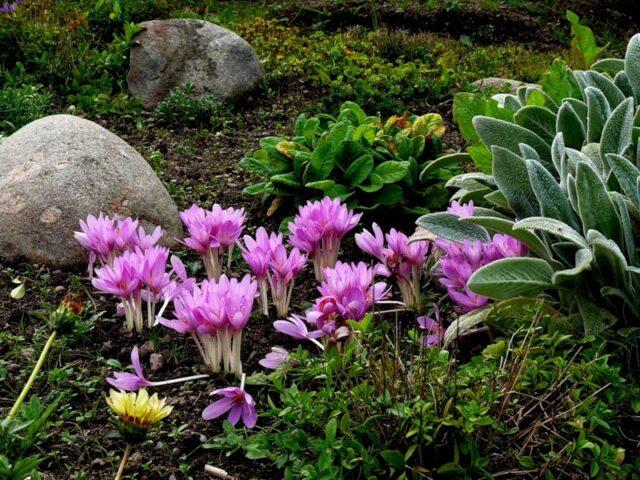
Autumn looks organically in low compositions among stones
Conclusion
The colchicum flower can decorate the area after all other perennials have withered and prepared for winter. Growing it in the countryside is quite simple; the plant’s care requirements are moderate. Autumn has many beneficial properties and is used for medicinal purposes.
